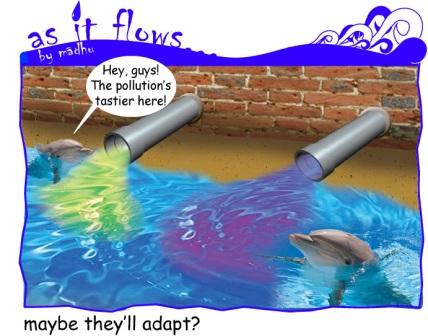/topics/forests
Forests
Applicability of remote sensing techniques to monitor changes in land use and water spread area in Koppal district of Karnataka – A research report by National Institute of Hydrology
Posted on 21 Jul, 2010 10:11 AMThe report deals with the applicability of remote sensing techniques to monitor changes in land-use and water spread area for the Yelbarga and Kustagi talukas of Koppal district in Karnataka. Information on the rate and kind of changes in land and water resources is essential for planning, management and regularizing the use of such resources.
Environment flows - Continuing the discussion
Posted on 21 Jul, 2010 12:41 AM
Seeds of hope - Case studies from the Planning Commission and Lokayan
Posted on 12 Jul, 2010 03:33 AMThis set of case studies is part of a book prepared by Lokayan in collaboration with the Planning Commission titled “Seeds of Hope", covers themes of agricultur
Land use and land cover mapping of Devak catchment, Jammu - A research report by National Institute of Hydrology
Posted on 22 Jun, 2010 07:25 PMThe study prepares a landuse and landcover map of Devak catchment of Ujh river basin in Jammu for the years 1958, 1979, 1990 and 1998 using image processing and visual interpretation techniques. It involves analysis of IRS-1A L2B2 (FCC) data for the year 1990, IRS -1C LISS III (digital data) for the year 1998 and SoI topographic maps for the year 1958 and 1979.
Effect of forest cover changes on sediment yield of Upper Indravati reservoir catchment - Orissa: A research report by National Institute of Hydrology
Posted on 21 Jun, 2010 02:08 AMThe study uses remote sensing data to develop a land use classification and applies statistical methods appropriate for Indian catchments to estimate the annual sediment load from the Upper Indravati catchment in Orissa for the year 2000. The study points to the fact that assessment of reservoir catchment regions at regular intervals would enhance the understanding of the geodynamic processes and help in identifying effective control measures.
Renukaji Dilli Ke Nalon Mein - A documentary about the movement against the proposed Renukaji Dam Project
Posted on 18 Jun, 2010 05:22 PMThe Renuka Dam Project proposed over the river Giri Ganga (a tributary of the Yamuna) located some 300km away from Delhi, is a joint project of the governments of Himachal Pradesh (HP) and Delhi, to be constructed by the Himachal Pradesh Power Corporation Limited (HPPCL) in Sirmaur district of HP.

Love for green: Healing the hills with trees - Work of Sachidanand Bharti in Uttarakhand (Video)
Posted on 12 Jun, 2010 12:01 PMLove for green: Healing the hills with trees - Work of Sachidanand Bharti in Uttarakhand
From Tubaah (NDTV Network) website (November 26, 2008).
Sachidanand Bharti is known as the treeman in Uttarakhand, where he has been dedicatedly planting trees since the last 25 years. Hills in Uttarakhand were once barren, but now they are lush green, all due to his efforts. Bharti is a school teacher by profession but his real calling is as a climate crusader.

Silviculture of Indian Trees:A book by Robert Scott Troup
Posted on 06 Mar, 2010 11:10 AMThe Silviculture of Indian Trees, is a seminal reference work in three volumes, that contains in-depth information (from a silvicultural point of view) about nearly all tree species of India, covering some 63 botanical orders. It is the outcome of twenty years of field-based research by Robert Scott Troup, a British forestry expert who spent much of his career in India, and is considered a classic landmark work on the subject.
The book starts with an introduction, followed by information organised by the botanical order, genera and finally, species. Each sub-section on a specific species, contains details such as the botanical name, vernacular names, distribution and habitat, silvicultural characters (climatic, temperature, soil conditions that help the tree grow), botanical descriptions as well as silhoutte drawings of the seed seedling leaf trunk root flower fruit bark and other plant parts, uses, flowering fruiting and leaf-shedding process as well as season, natural and artificial reproduction methods and rate of growth, germination process and role of animals birds insects wind and water, and botanically allied species.

State of the environment report - Tikamgarh district - Madhya Pradesh (2009)
Posted on 03 Oct, 2009 10:25 PMThis report on the state of the environment in Tikamgarh district, prepared by Development Alternatives, provides a summary of the environmental attributes and condition of the district and the human impacts on the environment. It also provides a public record of district authority, industry and community activities and achievements in responding to pressures on the environment. The purpose of this report is to bring out an overview of the environmental scenario of the district to serve as a baseline document and assist in logical and information based decision making.
The Subsidiary Body for Scientific and Technological Advice: A subsidiary body to the UNFCCC
Posted on 29 Aug, 2009 10:37 AMSome of the issues the SBSTA is currently dealing with are land use, land-use change and forestry, adaptation, mitigation, research, systematic observation and bunker fuels.




